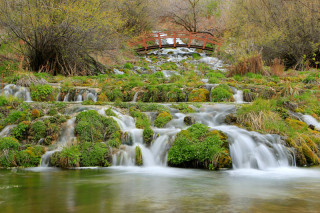Explorer Corps Marker: Wasatch County
Find the Marker
The Wasatch County marker is at the OHV trailhead at Wasatch Mountain State Park, in the ground between the restroom and the information and fee kiosk. The marker highlights Cascade Springs, natural spring water that flows over limestone terraces. The trailhead to Cascade Springs is located about five miles southeast from the marker.
GPS 40°29’26.736”N 111°29’31.056”W
Dig Deeper
Utah is a very dry state. Each year, only about 10 to 55 inches of precipitation falls on our state. But the sky isn’t the only source of water around. Sometimes water bubbles up from below ground, like at Cascade Springs in Wasatch County.

The nature of what makes Cascade Springs so special starts underground. Dr. Eric Rickart, NHMU's curator of vertebrate zoology, notes that below the surface, moving water dissolves calcium carbonate from limestone, dolomite, and other rocks. The minerals get mixed in with the water. That water is under pressure, part of what’s known as an artisanal spring, and burbles up to the surface where it flows over the stone.
The next part of the process is what gives Cascade Springs its character. On the surface, the mineral-laden spring water tumbles and flows over rock terraces and releases carbon dioxide gas. This, Rickart points out, changes the water chemistry. The calcium carbonate precipitates out of the water to create travertine – a form of crystallized limestone. It’s a very slow process that plays out at a very tiny scale, but consider this. More than seven million gallons of spring water flows over the terraces of Cascade Springs each day. Over time, all that calcium carbonate changes the shape of the terraces.
The pools and terraces support a rich array of wildlife. Aspens, maples, and oaks thrive around the springs, and flowers such as larkspur, sego lilies, and penstemons dot the nearby hills through the summer. You might be lucky enough to spot some of the local animals, too. Deer, moose, elk, wild turkeys, hummingbirds, beaver, and even otters rely on the habitat the springs have created, a quirk of geology providing the basis for abundant, astonishing wildlife.
You can even go have a look for yourself. There’s a 0.8 mile-long interpretive trail that will help you get a feel for the springs and the wildlife around it. The trail is wheelchair-friendly and allows leashed dogs, but it can also get quite busy. All the more reason to slow down, take your time, and watch carefully as you make your way around the flowing terraces.
Want to Go Farther?
Explore the trails and wildlife hikes surrounding the springs! From the marker, the trailhead to Cascade Springs is located about five miles southeast, and the trail to the springs is roughly half a mile. But it’s worth it for the series of beautiful springs, cascades, and pools.